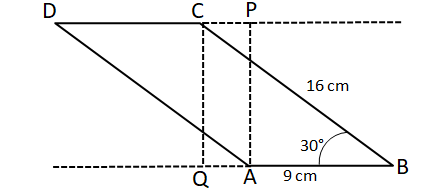Sign in
Please select an account to continue using cracku.in
↓ →
In a parallelogram ABCD of area 72 sq cm, the sides CD and AD have lengths 9 cm and 16 cm, respectively. Let P be a point on CD such that AP is perpendicular to CD. Then the area, in sq cm, of triangle APD is
In a parallelogram ABCD of area 72 sq cm, the sides CD and AD have lengths 9 cm and 16 cm, respectively. Let P be a point on CD such that AP is perpendicular to CD. Then the area, in sq cm, of triangle APD is

Given that area of parallelogram = 72 sq cm
Area of triangle ABC = $$\dfrac{1}{2}$$*area of parallelogram
(1/2)*AB*BC*sinABC = $$\dfrac{1}{2}$$*72
sinABC = $$\dfrac{1}{2}$$
$$\angle$$ ABC = 30°
Let us draw a perpendicular CQ from C to AB.

$$\angle\ B\ =\ \angle\ D\ =\ 30^{\circ\ }$$ ( opposite angles in a parallelogram)
$$\angle\ QCB\ =\ \angle\ DAP\ =\ 60^{\circ\ }$$ ( Sum of angles in a triangle = 180)
In triangles APD and CQB, AP= CQ , AD=CB ( opposite sides of a parallelogram) , $$\angle\ QCB\ =\ \angle\ DAP\ =\ 60^{\circ\ }$$
Hence APD and CQB are congruent triangles using SAS property.
Therefore, we can say that area of triangle APD = area of triangle CQB
In right angle triangle CQB,
QB = CBcos30° = $$16*\dfrac{\sqrt{3}}{2}$$ = $$8\sqrt{3}$$ cm
CQ = CBsin30° = $$16*\dfrac{1}{2}$$ = $$8$$ cm
Therefore, area of triangle CQB = 1/2*CQ*QB = $$1/2*8*8\sqrt{3}$$ = $$32\sqrt{3}$$
Hence, we can say that area of triangle APD = $$32\sqrt{3}$$.

Click on the Email ☝️ to Watch the Video Solution
Create a FREE account and get:
Educational materials for CAT preparation